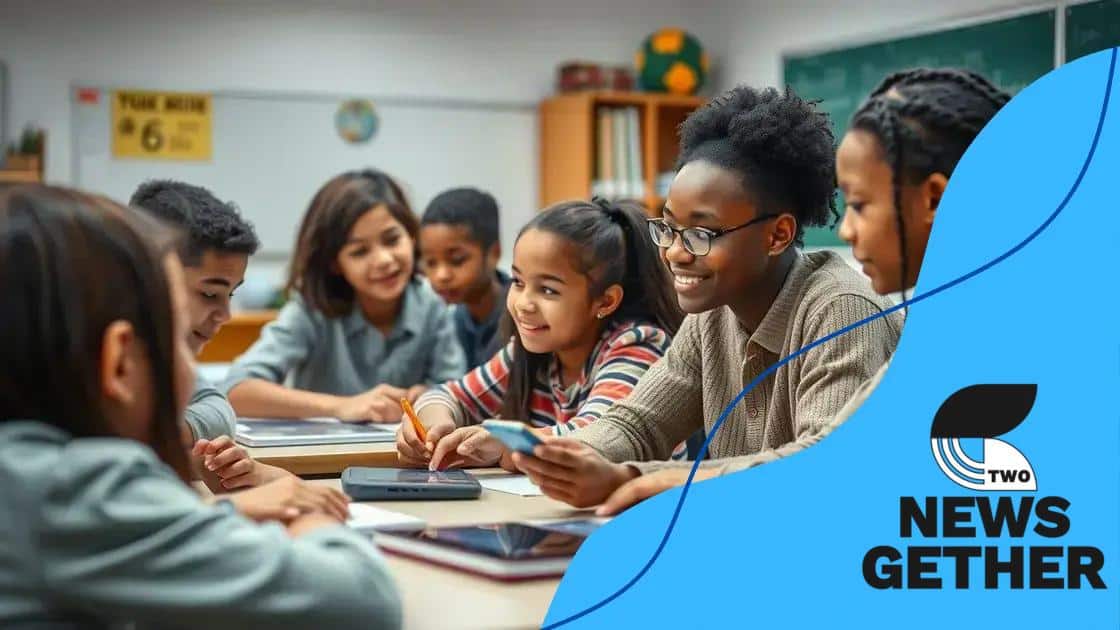How AI is personalizing learning experiences in higher education

AI is personalizing learning experiences in higher education by analyzing student data to create tailored educational paths, enhancing engagement, and providing real-time feedback for improved outcomes.
How AI is personalizing learning experiences in higher education is transforming the way students engage with their studies. Have you ever wondered how technology can shape your educational journey? Let’s dive into this fascinating topic.
Understanding the role of AI in education
Understanding the role of AI in education is essential to grasp how technology reshapes learning. With the rise of digital tools, AI has become a powerful ally in the classroom, providing insights and resources.
How AI Enhances Learning
AI personalizes education by analyzing students’ learning patterns. This data helps in creating tailored experiences. For instance, adaptive learning platforms adjust content based on performance, making lessons more engaging.
- Improves student engagement.
- Identifies knowledge gaps.
- Offers customized resources.
This individualized approach means that no two learning experiences are exactly the same. By fostering a more relevant and personalized environment, AI keeps students motivated.
Data-Driven Insights
Educators can utilize AI to gain valuable insights into student behavior. Through analysis of data, they can identify trends and areas needing attention. This means instructors can offer timely support where it matters most.
- Tracks student progress.
- Enhances teaching strategies.
- Facilitates informed decision-making.
Moreover, AI tools streamline administrative tasks. This allows educators to focus more on teaching and less on paperwork. In turn, this leads to more meaningful interactions with students.
Overall, the role of AI in education is transformative. It empowers both students and teachers, paving the way for an efficient and engaging learning atmosphere.
Benefits of personalized learning through AI
The benefits of personalized learning through AI are significant and wide-ranging. By tailoring education to meet individual student needs, AI enhances the learning experience, making it more effective and engaging.
Improved Engagement
Personalized learning captures students’ attention better than traditional approaches. When lessons are tailored, students feel a connection to the material. This connection increases motivation and interest in their studies.
- Enhances student participation.
- Boosts motivation through relevant content.
- Promotes a sense of ownership over learning.
As a result, learners are more willing to take risks and explore new ideas. Instead of feeling lost, they find joy in discovering knowledge.
Customized Learning Paths
Another major advantage is the creation of customized learning paths. AI analyzes data to determine students’ strengths and weaknesses. This information helps educators design lessons that suit each learner’s unique needs.
- Addresses individual learning styles.
- Allows for flexible pacing.
- Incorporates varied learning materials.
This level of customization removes the one-size-fits-all mentality in education. Instead, it acknowledges that each student has a different journey.
Moreover, the use of AI facilitates real-time feedback. Students receive instant evaluations on their performance, allowing them to adjust their efforts. This immediate response enhances their ability to learn and adapt quickly.
In conclusion, harnessing the power of AI in education opens up a world of possibilities for personalized learning. It cultivates an environment where students thrive and teachers can effectively assist each learner.
Real-world examples of AI in higher education

Real-world examples of AI in higher education showcase how institutions harness technology for improved learning experiences. These applications highlight the transformative potential of AI in educational settings.
Adaptive Learning Platforms
Many universities use adaptive learning platforms to cater to diverse student needs. These systems analyze performance data and adjust content to suit individual learning paces. For example, institutions like Georgia State University employ these tools to enhance student retention and success by personalizing course materials.
- Tailors lessons based on skill levels.
- Promotes individualized feedback and assessments.
- Reduces dropout rates.
By creating targeted paths, students feel more confident and engaged in their studies.
AI-Powered Tutoring Systems
AI-driven tutoring systems are also gaining traction. Schools like Carnegie Mellon University utilize intelligent tutoring systems that provide real-time assistance. These platforms identify areas where students struggle and offer instant feedback.
- Fosters independent learning.
- Provides 24/7 support.
- Encourages problem-solving skills.
This means learners can seek help anytime, creating a supportive and enriching environment.
Additionally, universities are integrating AI for administrative tasks. By using chatbots for student inquiries, institutions like Arizona State University enhance communication while freeing up staff time.
Overall, these real-world examples illustrate the varied ways AI enhances the educational landscape, making higher education more accessible and effective.
Challenges and ethical considerations
While AI offers many benefits in education, it also brings challenges and ethical considerations that must be addressed. Recognizing these issues is essential for effective implementation in higher education.
Data Privacy Concerns
One of the primary challenges is data privacy. AI systems collect vast amounts of data to personalize learning. This raises questions about how student information is stored and used. Safeguarding personal data is crucial to maintain trust.
- Ensuring compliance with privacy laws.
- Protecting sensitive student information.
- Establishing clear data usage policies.
Without proper precautions, sensitive data may be at risk of misuse or exposure, leading to significant consequences for students and institutions alike.
Bias in AI Algorithms
Another critical issue is bias in AI algorithms. If the data used to train these systems is not diverse and representative, it may lead to unfair outcomes. For example, biased algorithms can affect grading or resource recommendations, disadvantaging certain groups of students.
- Addressing algorithmic bias is essential.
- Incorporating diverse data sets in training.
- Regularly auditing AI systems for bias.
That’s why ongoing monitoring and adjustment are necessary to ensure AI tools serve all students equitably.
Additionally, relying heavily on technology can reduce human interaction. This is especially concerning in education, where personal relationships are vital. Educators should balance the use of AI with direct student engagement to foster a supportive learning environment.
In summary, while the potential of AI in education is vast, tackling these challenges will require careful planning and ethical considerations to maximize benefits while minimizing risks.
Future trends in AI-driven education
Future trends in AI-driven education are shaping a new landscape for learning. As technology continues to evolve, educational institutions are adopting innovative solutions to enhance the learning experience.
Increased Use of Virtual Reality
One exciting trend is the integration of virtual reality (VR) into education. VR allows students to immerse themselves in simulated environments, making complex concepts easier to understand.
- Enables experiential learning.
- Enhances engagement through interactive content.
- Offers unique field trip experiences without leaving the classroom.
This technology helps students visualize difficult subjects, such as science and history, in a more engaging way.
Personalized Learning Experiences
The future will likely see even more personalized learning experiences, powered by advanced AI algorithms. These algorithms will adapt to individual learning styles and preferences, ensuring each student receives the support they need.
- Adapts coursework based on student performance.
- Incorporates real-time feedback and assessments.
- Offers customized learning paths for different abilities.
This more tailored approach improves student outcomes, making learning more effective and relevant.
Another emerging trend is the use of AI for administrative efficiency. Institutions will likely rely on AI to streamline operations, from admissions to grading, allowing educators to focus more on teaching. This shift will create a more productive learning environment and reduce workloads for teachers.
As technological advancements continue, it is vital to prepare for these changes. Educators must stay informed about the latest developments to effectively integrate these tools into their teaching practices.
In conclusion, exploring how AI is personalizing learning experiences in higher education reveals its vast potential. The integration of AI technologies not only enhances student engagement but also allows for tailored educational paths. As we look to the future, being aware of the ethical challenges and trends will help educators maximize these benefits. Ultimately, the goal is to create a more inclusive and effective learning environment for all students, supporting their individual journeys toward success.
FAQ – Common Questions About AI in Higher Education
How does AI personalize learning experiences?
AI analyzes student data to create tailored educational paths, adapting content and feedback to meet individual needs.
What are some examples of AI being used in universities?
Universities use AI for adaptive learning platforms, AI-powered tutoring systems, and administrative tasks like chatbots for student support.
What ethical concerns are associated with AI in education?
Key concerns include data privacy, algorithmic bias, and the potential reduction of human interaction in the learning process.
What future trends should we expect in AI-driven education?
We can expect more use of virtual reality, advanced personalization of learning experiences, and increased automation of administrative tasks.






